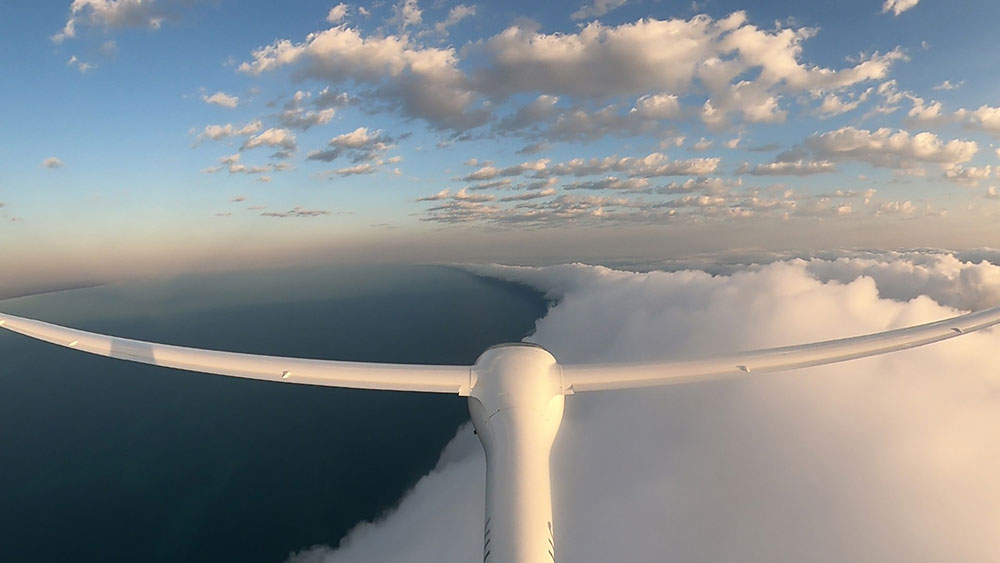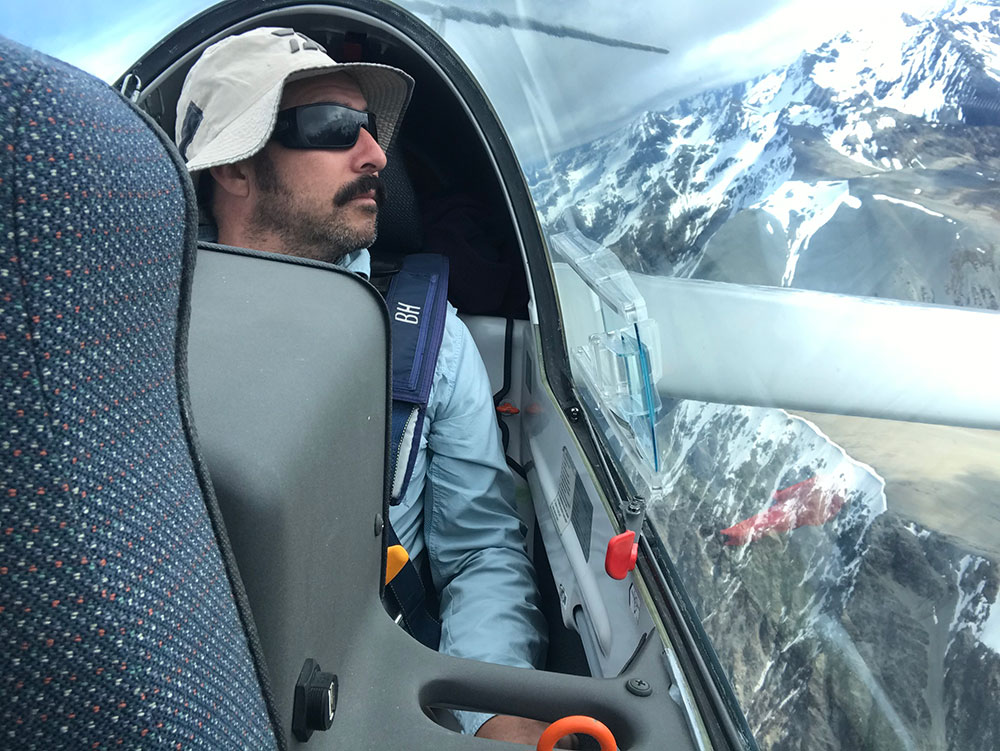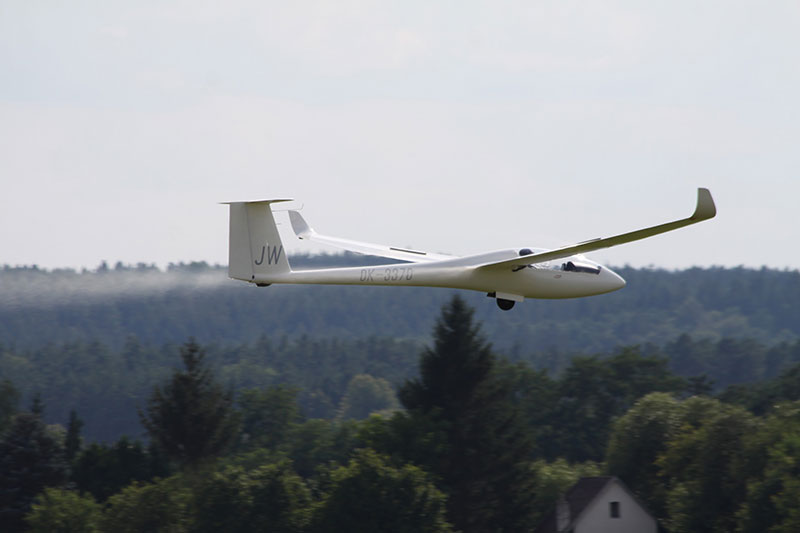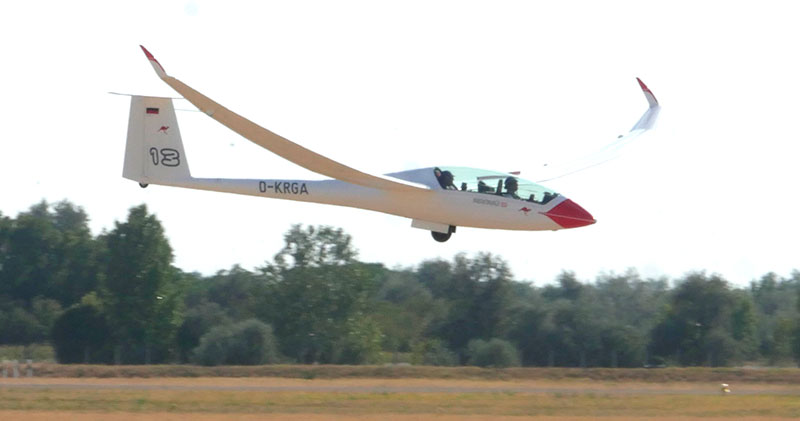Over the years I have made many attempts at a 1,000km flight in a 15m glider. With the LS4 I managed flights of over 980, 970 and 960km, but never quite made the 1,000 mark.
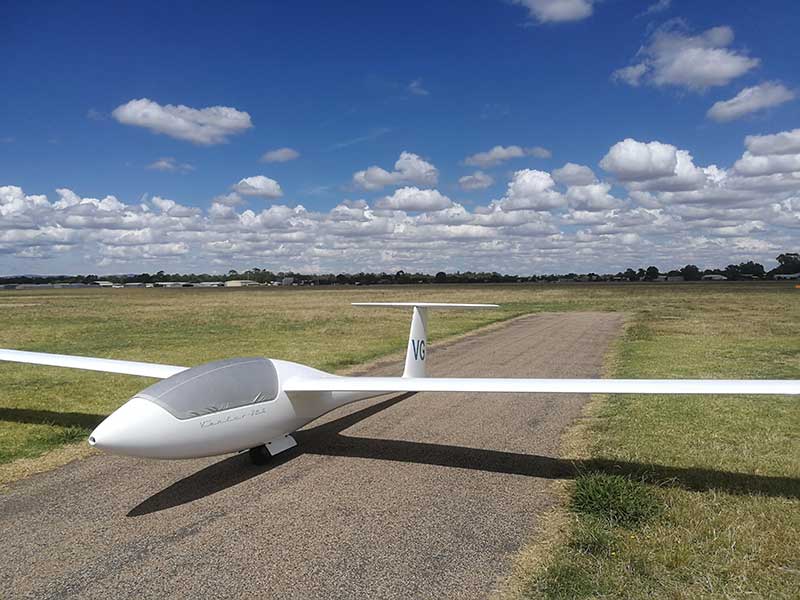
Late morning Cumulus cloud west of Benalla on 5 January 2021 at the eastern flank of a high-pressure system over the Bight. This marked the beginning of the build-up to a couple of hot and unstable days forecast to arrive ahead of the hottest day on 11 January.
By Tobias Geiger
When I bought a Ventus 2ax from the US in 2018, I hoped to finally break through that ceiling, given the Ventus’ superior performance compared to the LS4. Finally, on 4 January 2019 I did my first flight over 1,000km with a distance of 1,038km.
Now I had my eyes firmly set on achieving a declared 1,000km flight to get the 1,000km Diploma from the GFA and FAI. Due to rolling lockdowns and border closures triggered by various Corona virus outbreaks across Australia, my annual leave this season would be spent on a holiday at my home airfield at Benalla. It seems fitting that, when I wrote this article, we were in lockdown again in Victoria and instead of gliding, I was sitting at home in front of my computer. How sad is that in February?
Narrow Escape
Prior to Christmas, we had an escapee experience that left a lasting impression when we travelled to Sydney for work, with a holiday planned to follow in Bellingen. We made it as far as Nambucca Heads, when the news about border restrictions on re-entry into Victoria for people who had been in the greater Sydney area became more and more worrying. We made a rushed 15-hour drive from Nambucca Heads back home, and we were fortunate that, after a night and a day in isolation at home and two negative COVID tests, we could move freely in Victoria again. Had we been delayed just two days more, we would have been stuck in NSW for weeks and missed Christmas at home with family and friends.
I arrived at Benalla late on Christmas Day and was really looking forward to three weeks of long distance flying. Boxing Day turned out to be a good day and I managed a flight of over 786km. Then the weather turned a bit stable for a few days and I went overnight hiking in the Alps instead of flying. This was a great break from it all, as 2020 had been a very difficult year for our business. Having a couple of days by myself in the bush helped me process a lot of things and put life and work into perspective again. After my time with nature, my head was free and ready for some gliding adventures.
With the border still closed between NSW and Victoria, task planning was heavily focused on turnpoints within Victoria, very little flying over NSW and only within glide range back to Victoria. At the time, an outlanding in NSW could have meant an uncertain waiting period somewhere in NSW until the Victorian border opened again and two weeks hotel quarantine upon re-entry. As many would know, most long-distance flying from Benalla goes into NSW. As a result, a big re-think in task planning happened among the group of cross-country gliding pilots at Benalla.
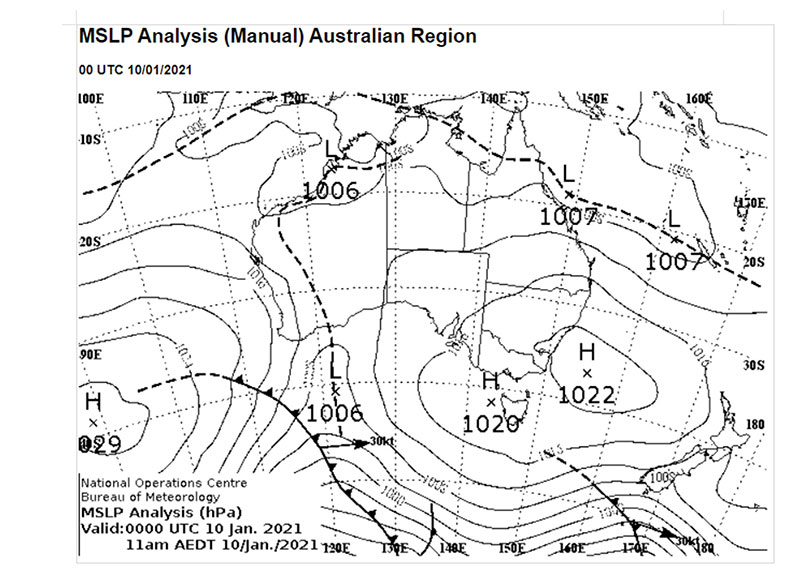
Synoptic mean sea level pressure chart for 10 January 2021. Victoria remained under a large high-pressure system with light north-westerly winds in the task area and no high level disturbances (no Cirrus).
Serious Crack
Following on from a couple of good flights, the day to give a 1,000km flight a serious crack finally came on 7 January 2021. I attempted a triangle starting on the leg at Benalla, first turnpoint was Cheshunt in the hills to the south east, then Avoca, Nangiloc and back to Benalla. The first partial leg went really well with Cu's popping in front of me when I needed them on my way to Cheshunt.
But just short of the turnpoint, I found myself at the wrong end of a cycle and effectively had to 'park' there, losing a valuable 10 minutes. From there onward, my average speed remained below the speed I needed to complete the triangle. According to my flight plan, I would need to turn Nangiloc by 4.30pm if I was to have a reasonable chance of making it back home. Nevertheless, at 4.53pm I turned about 45km short of Nangiloc as it was clear I wouldn’t make it there and back to Benalla in time before the day shut down. The day ended with a very interesting 968km flight and a landing at Benalla just before 8pm.
Seize the Day
The next opportunity for the magic 1,000km came on 10 January. Many speculated that the 11th would be the best day of this cycle with a trough approaching from the west and hot temperatures forecast, combined with very high cloud bases and strong thermals. However, thinking that the wind speeds at altitude forecast for the 11th were too high for a very long distance flight, I decided to give the 10th a go instead. Too many times I have heard the words, “You should have been here yesterday”.
With mostly blue thermals, 10 January didn’t look like a particularly strong day. On the other hand, it was forecast to be a long day with light winds, thermals topping out around 9,000ft during the main part of the day and with Cu's and cloud bases up to 12,500ft forecast later in the day to the south and southwest of Benalla.
Good enough, I thought, to give it a good go and fill about 150 litres of water into the wings. That gave me a wing loading of about 52kg/m2, which for me is a good balance in the 15m Ventus 2ax, when you need to find the cores of thermals in the blue reasonably quickly yet want to cruise at 100 to 110kts between thermals. I find it hard, and probably quite inefficient, to stay in the core of thermals when the core moves around and you have to constantly chase it with the Ventus’ wing loading at its maximum of 55kg/m2.
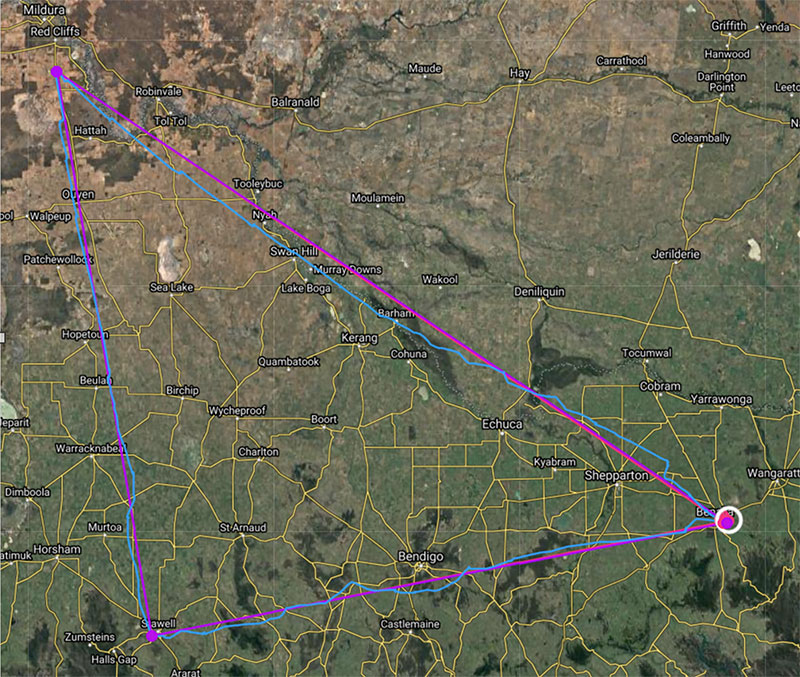

Declared task and trace of the 1,008km FAI triangle over Victoria on 10 January 2021.
FAI Triangle
At the launch point, there was an atmosphere of excitement and Ryan Driscoll had already lined up the LS7 when I arrived there just before 11am. He would do his first 750km flight that day. When I released from the tug at 11.23am I thought I was already behind schedule. However, both Ryan and I had to mill around the airfield for another 15 minutes before we had climbed to 4,000ft MSL and I eventually crossed my start line at 11.39pm at around 3,800ft. Ahead it was all blue on track. The air seamed reasonably buoyant up to 4,000ft MSL though, which gives you a workable height band above the general ground level of 600ft around Benalla in the early part of the day.
The task I had set for myself on that day was again an FAI triangle with the start point at Benalla. The first declared turnpoint was Carwarp south of Mildura, then Stawell just north-east of the Grampians and then back to Benalla. I had again set times by which I needed to be at the two turnpoints in order to achieve the required average speed to complete the task. I was to reach Carwarp by 3pm and Stawell ideally by 5pm but no later than 5.30pm. I assumed that I’d find thermals until around 7 to 7.15pm and that it was going high enough and there were remnant Cu's to allow me to stretch the glide until about 8pm as I did a few days earlier.
Ten minutes after I had left Benalla, I took the first decent climb for the day that took me from 2,000ft MSL to 4,200ft with an average climb rate of around 6kts. From there I headed towards the Dookie Hills where, surprisingly, a small wispy Cu had formed over Mt Major, the main hill. By the time I arrived there, though, the Cu had disappeared.
Following Wisps
However, another two small wisps started to form about 5km off track to the north. The first one seemed pretty disappointing, with climb rates around 2 to 4kts. But I had descended to 2,300ft MSL and wasn’t sure I’d make it to the next wisp in time and high enough before it dissipated again. Yet, 2 to 4 kts climb rate were too little to get to the average speed I needed to achieve.
So, I left that climb after searching for three turns and kept tracking 90 degrees off track to make it to the last wispy Cu there was. Thankfully that one didn’t disappoint, as I climbed with an average of around 5 to 6 kts from 3,300ft to 7,200ft and left that climb about 40km into the flight at 12.13pm. Now the race was on!
For the next hour I managed to stay in a height band between 4,000 and 8,000ft and had a good rhythm between good blue thermals with average climb rates around 5 to 7kts. As I approached the Murray River, the next few wispy Cus started to appear ahead and I zigzagged for the next 30km or so to extract as much energy as I could while avoiding too many turns in thermals. This allowed me to gain altitude and for the first time I saw 9,000ft on the altimeter at around 1.15pm over the forests that straddle the Murray along the border between Victoria and NSW.
Gathering Speed
My average speed had by now increased to more than 100km/h. From here on in though there were no more signs of any Cu for the next 500km. Nonetheless, the thermals worked quite reliably in the blue and I continued with a good run straight down the line in a height band between 4,000 and 9,000ft.
By the time I reached Carwarp at 2.58pm, my average speed since crossing the start line – about 3 hours 20 minutes earlier – had improved to 125km/h and I figured that if I could maintain that speed, I should be able to finish the 1,000km in about 8 hours in total and be on short final 20 minutes to 8pm. My confidence grew and I became excited that for the first time I might be able to complete a declared 1,000km task.
At the beginning of the leg towards Stawell, I could see that, far in the distance, the sky was filled with nice looking Cu's and I hoped that they would still be there by the time I reached Stawell. The thermals over the Mallee kept pumping reliable 6 and 7kts climbs and my average speed kept going up slowly. I was typically cruising at 110kts between climbs by then. Approximately 50km north of Stawell I finally connected with the first real plum Cumulus cloud of the day and it produced a very welcome 10kts average bottom to top climb from 5,000 to 11,000ft.
Ballast Benefit
Now I could finally use the full benefit of the water ballast and cruise in good energy lines under the Cus. I reached Stawell just after 5pm and the average speed on the second leg was 142km/h. The average speed for the flight overall had just improved to over 130km/h and the wind remained a fairly moderate northwesterly.
I was very pleased that I had a very small tail wind component on the way home, as I was cruising over several wind farms north of Ararat. Working in the wind energy industry, I knew quite well which windfarm was which, what turbines are installed there and how long the journey has been for all those wind energy projects – probably as long as my 10-plus years of attempting to fly a 1,000km. Great to see them finally spin and pump electricity into the national electricity grid.
As I approached the area southwest of Bendigo, I saw that I was at the tail end of the cycle that had produced a number of good looking Cu’s. They were no longer working by the time I got there, and I found myself down to 3,000ft MSL (2,000ft AGL). Not the place you want to be when the cloud base is at around 12,000ft and the next 15km are very tricky for an outlanding.
Looking for Bubbles
I chose to accept a weak 2kts climb and hoped that the trigger for the decaying Cu that I was under now would soon produce another bubble. When I reached 4,000ft it finally did, and a fresh bubble improved the average climb rate to 5 to 6kts. I left in 6,500ft as the sky ahead looked more promising again and I could easily make it beyond an area dominated by little hills and ridges, small patches of bushland and even smaller paddocks dotted with hobby farms and power lines.
Thermal by thermal I increased my altitude again before I climbed to final glide altitude at just under 12,000ft a little past the Colbinabbin ranges. It was 6.30pm now and the distance to Benalla was around 95km.
You made it! On this long final glide I took some small deviations to follow energy lines under Cu's. About 20km short of Benalla I flew into a 3kts climb and started turning as I thought I could stretch this flight a bit further. After a couple of turns I thought, “This is too much work. I should go home instead, put the glider away, have a nice dinner and a well-deserved beer with friends.”
Unknowing Record
I arrived nice and high back at Benalla, flew a big circuit and landed at 7.15pm. The LX9000 showed me an average speed over the 1,008km task of 134km/h and I was very pleased with that. Little did I know at that stage what that average speed meant. As I towed the Ventus to the hangar I saw my official observer Craig Blunt open the hangar door for me. I was very thankful not just for the open hangar but also Craig’s great support in getting the paperwork sorted out. Thanks a lot Craig, really appreciate the help and support that you always lend freely to your friends!
As I sat among my club mates enjoying a cold beer, someone mentioned this could be a national record. I didn’t believe that at the time, as I didn’t think it was a particularly fast day nor had I pushed particularly hard. Craig, who flew 769km that day in his ASW17, also said that while in his view it was a good day, it wasn’t that good.
Anyway, I thought I’d better check the GFA list of Australian records and I was very surprised when I saw that the previous 1,000km speed record for the FAI triangle in a 15m glider stood at 120km/h, achieved by Greg Beecroft in a LS8 many years before. So I put in a claim for the 1,000km diploma and the speed record in 15m class for the 1,000km FAI triangle.
Confirmation
Thanks to GFA’s all-electronic system, I had confirmation within a few days that I had successfully achieved both claimed performances – and all of that, except for a short section north of Echuca, south of the river Murray in Victoria.
No doubt we will continue to explore the west of our state more often now out of Benalla than we have in the past. With or without border closures, the countryside there is far less scary when you get lower than the Hay Plains. My next big challenge in long-distance gliding might now be 1,000km with a significant proportion of the flight over the picturesque mountain landscapes of the Australian Alps – although, it looks much scarier there when you get low than the Hay Plains. Maybe I should re-consider that idea…




























